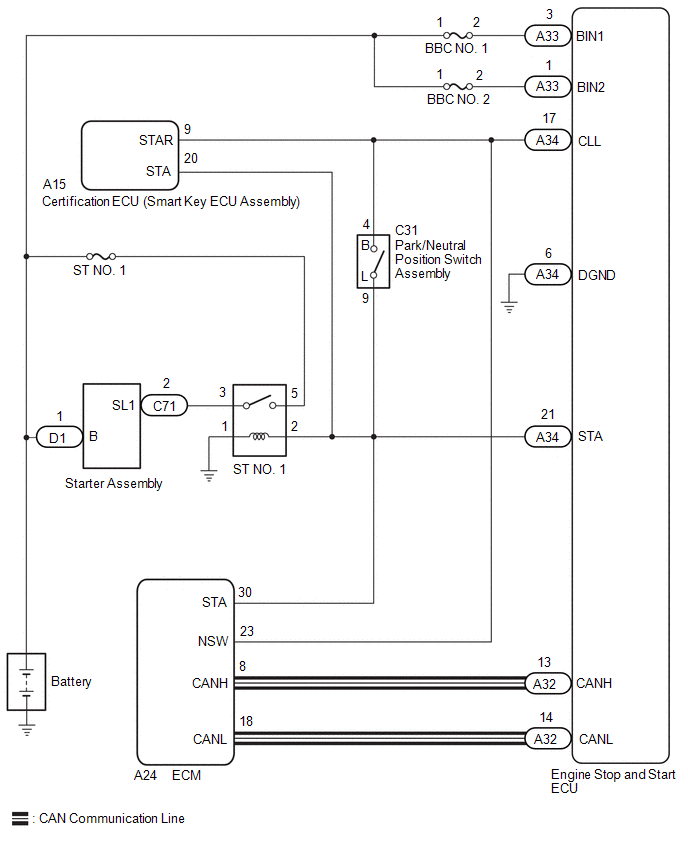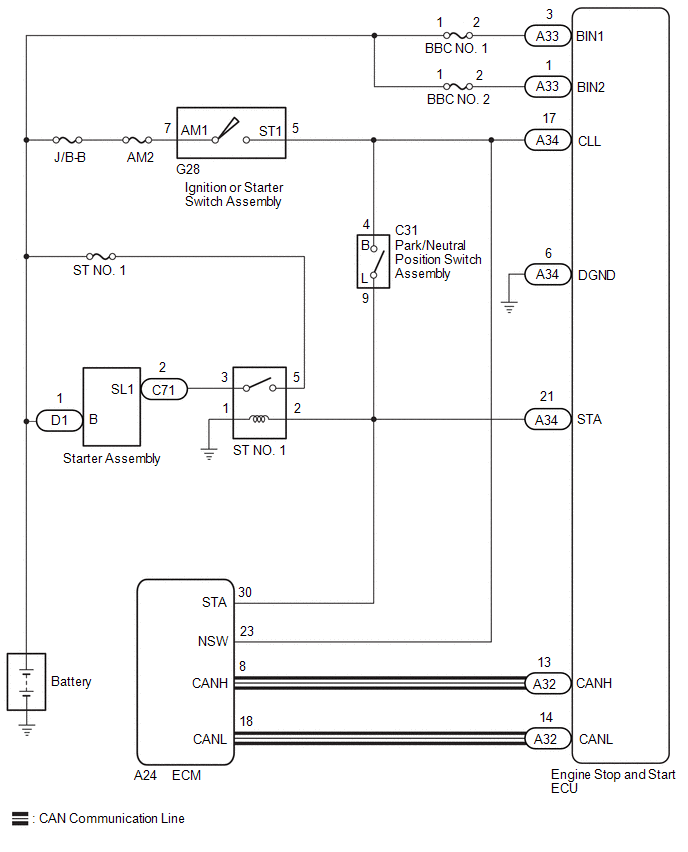| Last Modified: 01-30-2024 | 6.11:8.1.0 | Doc ID: RM100000002EMA4 |
| Model Year Start: 2024 | Model: RAV4 | Prod Date Range: [10/2023 - ] |
| Title: STOP AND START: STOP AND START SYSTEM: P061511; Starter Relay Circuit Short to Ground; 2024 MY RAV4 [10/2023 - ] | ||
|
DTC |
P061511 |
Starter Relay Circuit Short to Ground |
DESCRIPTION
When the engine is started by stop and start control, the engine stop and start ECU controls the starter assembly by activating the ST NO. 1 relay via voltage from terminal STA.
If overcurrent is detected in the starter relay circuit, the engine stop and start ECU stores DTC P061511.
|
DTC No. |
Detection Item |
DTC Detection Condition |
Trouble Area |
MIL |
Warning Indicate |
Note |
|---|---|---|---|---|---|---|
|
P061511 |
Starter Relay Circuit Short to Ground |
Both of the following conditions are met for 1 second (1 trip detection logic):
|
|
Comes on |
Does not come on |
SAE Code: P0617 |
MONITOR STRATEGY
|
Related DTCs |
P0616: Starter relay range check (low voltage) |
|
Required Sensors/Components (Main) |
Engine stop and start ECU |
|
Required Sensors/Components (Related) |
ST NO.1 relay |
|
Frequency of Operation |
Continuous |
|
Duration |
1 second |
|
MIL Operation |
Immediate |
|
Sequence of Operation |
None |
TYPICAL ENABLING CONDITIONS
|
All of the following conditions are met |
- |
|
Write Inhibit |
permit |
|
Time after Write status forbiddance to permit |
0.5 seconds or more |
|
Ignition switch |
ON |
|
Time after ignition switch is off to ON |
0.5 seconds or more |
|
Engine stop and start ECU internal starter relay circuit fail (P1644) |
Not detected |
|
Engine stop and start ECU internal high side switch for starter relay |
ON |
|
Engine stop and start ECU internal low side switch for starter relay |
ON |
TYPICAL MALFUNCTION THRESHOLDS
|
Starter relay overcurrent |
Detected |
CONFIRMATION DRIVING PATTERN
HINT:
-
If the cable is disconnected from the battery terminal, stop and start control is prohibited until refresh charge is completed.
In this case, let the vehicle idle to complete the refresh charge. The refresh charge is complete when the Data List item "Status of Battery Charge Control" changes from "Refresh Charge Mode". (Usually, idling the engine for 5 to 60 minutes with the battery fluid temperature at 11°C (51°F) or higher, the refresh charge will be completed.)
-
If the Techstream is not available and the Data List item "Status of Battery Charge Control" cannot be checked, charge the battery by idling the engine for approximately 5 to 60 minutes or driving the vehicle, and then drive the vehicle and check that stop and start control operates.
If the engine is started with the hood open, the system determines that a jump start has occurred. Therefore, make sure that the hood is closed before starting the engine and driving the vehicle.
- After the refresh charge completes, turn the ignition switch off, wait for at least 30 seconds, and then start the engine again. If the vehicle enters refresh charge mode again while the engine is idling, the initial refresh charge did not properly complete, so wait for the refresh charge to complete.
- Allow the engine to idle for 3 minutes after it is warmed up and check that the engine idle speed is within 50 rpm of the target idle speed.
- When clearing the permanent DTCs, refer to the "CLEAR PERMANENT DTC" procedure.
- When clearing the permanent DTCs, do not disconnect the cable from the battery terminal or attempt to clear the DTCs during this procedure, as doing so will clear the universal trip and normal judgment histories.
CONFIRMATION AFTER TROUBLESHOOTING
(a) Connect the Techstream to the DLC3.
(b) Turn the ignition switch to ON.
(c) Turn the Techstream on.
(d) Clear the DTCs.
Powertrain > Stop and Start > Clear DTCs
(e) Start the engine and warm it up.
(f) Drive the vehicle at 7 km/h (4 mph) or more.
CAUTION:
When performing Confirmation Driving Pattern, obey all speed limits and traffic laws.
(g) Depress the brake pedal and stop the vehicle.
(h) Keep the engine stopped by stop and start control for 1 second or more. (Keep the shift lever in D.)
(i) Release the brake pedal with the shift lever in D to start the engine.
(j) Check that DTCs are not output.
Powertrain > Stop and Start > Trouble Codes
STOP AND START SYSTEM OPERATION CHECK
WIRING DIAGRAM
w/ Smart Key System

w/o Smart Key System

CAUTION / NOTICE / HINT
NOTICE:
- Before replacing the engine stop and start ECU, read the number of starter operations and write it into a new engine stop and start ECU.
- After replacing the engine stop and start ECU or air conditioning amplifier assembly, reset and perform learning of the air conditioning information in the engine stop and start ECU.
- After replacing the engine stop and start ECU or airbag ECU assembly, clear and calibrate the deceleration sensor zero point in the engine stop and start ECU.
- When the engine stop and start ECU or oil pump with solenoid assembly is replaced, check the oil pump with solenoid assembly.
- Inspect the fuses for circuits related to this system before performing the following procedure.
HINT:
- Using the Techstream, read the freeze frame data before troubleshooting. System condition information is recorded as freeze frame data the moment a DTC is stored. This information can be useful when troubleshooting.
- DTCs for the stop and start system are not cleared even if the malfunction has been repaired. After repairing the malfunction, be sure to clear the DTCs.
PROCEDURE
|
1. |
CHECK HARNESS AND CONNECTOR (ENGINE STOP AND START ECU - BBC NO. 1 FUSE AND BBC NO. 2 FUSE) |
(a) Disconnect the engine stop and start ECU connector.
(b) Remove the BBC NO. 1 fuse and BBC NO. 2 fuse from the No. 1 engine room relay block and No. 1 junction block assembly.
(c) Measure the resistance according to the value(s) in the table below.
Standard Resistance:
|
Tester Connection |
Condition |
Specified Condition |
|---|---|---|
|
A33-1 (BIN2) - BBC NO. 2 fuse terminal 2 |
Always |
Below 1 Ω |
|
A33-3 (BIN1) - BBC NO. 1 fuse terminal 2 |
Always |
Below 1 Ω |
|
A33-1 (BIN2) or BBC NO. 2 fuse terminal 2 - Body ground and other terminals |
Always |
10 kΩ or higher |
|
A33-3 (BIN1) or BBC NO. 1 fuse terminal 2 - Body ground and other terminals |
Always |
10 kΩ or higher |
| NG |

|
REPAIR OR REPLACE HARNESS OR CONNECTOR (ENGINE STOP AND START ECU - BBC NO. 1 FUSE OR BBC NO. 2 FUSE) |
|
|
2. |
CHECK HARNESS AND CONNECTOR (ENGINE STOP AND START ECU - ST NO. 1 RELAY) |
(a) Disconnect the engine stop and start ECU connectors.
(b) Remove the ST NO. 1 relay from the No. 1 engine room relay block and No. 1 junction block assembly.
(c) Disconnect the certification ECU (smart key ECU assembly) connector. (w/ Smart Key System)
(d) Disconnect the park/neutral position switch assembly connector.
(e) Disconnect the ECM connector.
(f) Measure the resistance according to the value(s) in the table below.
Standard Resistance:
|
Tester Connection |
Condition |
Specified Condition |
|---|---|---|
|
A34-21 (STA) - 2 (ST NO. 1 relay) |
Always |
Below 1 Ω |
|
A34-21 (STA) or 2 (ST NO. 1 relay) - Body ground and other terminals |
Always |
10 kΩ or higher |
|
A33-1 (BIN2) - A34-21 (STA) |
Always |
10 kΩ or higher |
|
A33-3 (BIN1) - A34-21 (STA) |
Always |
10 kΩ or higher |
| NG |

|
REPAIR OR REPLACE HARNESS OR CONNECTOR (ENGINE STOP AND START ECU - ST NO. 1 RELAY) |
|
|
3. |
CHECK ENGINE STOP AND START ECU |

|
*a |
Component without harness connected (Engine Stop and Start ECU) |
- |
- |
(a) Disconnect the engine stop and start ECU connector.
(b) Measure the resistance according to the value(s) in the table below.
Standard Resistance:
|
Tester Connection |
Condition |
Specified Condition |
|---|---|---|
|
A34-21 (STA) - A34-6 (DGND) |
Always |
10 kΩ or higher |
| NG |

|
|
|
4. |
INSPECT RELAY (ST NO. 1 RELAY) |
(a) Inspect the ST NO. 1 relay.
| OK |

|
| NG |

|
REPLACE RELAY (ST NO. 1 RELAY) |
|
|
|
![2024 MY RAV4 [10/2023 - ]; STOP AND START: STOP AND START SYSTEM: DTC CHECK / CLEAR](/t3Portal/stylegraphics/info.gif)
